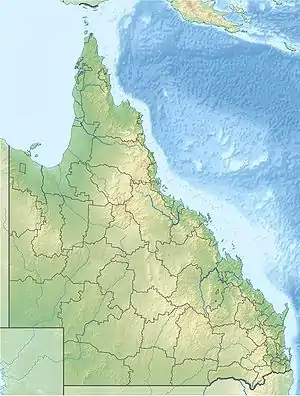Tully River
The Tully River is a river located in Far North Queensland, Australia.
| Tully | |
|---|---|
 The Tully River, 2009 | |
 Location of Tully River mouth in Queensland | |
| Etymology | In honour of William Alcock Tully[1] |
| Location | |
| Country | Australia |
| State | Queensland |
| Region | Far North Queensland, Wet Tropics of Queensland |
| City | Tully |
| Physical characteristics | |
| Source | Cardwell Range, Great Dividing Range |
| • location | Kirrama State Forest |
| • coordinates | 17°58′53″S 145°37′18″E |
| • elevation | 800 m (2,600 ft) |
| Mouth | Coral Sea |
• location | Tully Heads |
• coordinates | 18°01′55″S 146°03′25″E |
• elevation | 0 m (0 ft) |
| Length | 133 km (83 mi) |
| Basin size | 1,650 km2 (640 sq mi) |
| Basin features | |
| Tributaries | |
| • left | Nitchaga Creek, Jarra Creek |
| • right | Cochable Creek, Davidson Creek, Echo Creek |
| National park | Tully Gorge National Park |
| [2][3] | |
Course and features
The Tully River rises in the Cardwell Range, part of the Great Dividing Range on the northern boundary of the Kirrama State Forest. The river flows generally north through Lake Koombooloomba and flows over the Tully Falls near Ravenshoe and descends through the Tully Gorge within the Tully Gorge National Park, part of the UNESCO World Heritage–listed Wet Tropics site. Below the dam wall, the river is joined by five minor tributaries before emptying into the Coral Sea at Tully Heads. The river descends 800 metres (2,600 ft) over its 133-kilometre (83 mi) course.[2]
People and land use
The Tully, together with the Herbert and the Burdekin rivers, were part of the proposed Bradfield Scheme to divert the upper reaches of the three rivers west of the Great Dividing Range and into the Thomson River designed to irrigate and drought-proof much of the western Queensland interior, as well as large areas of South Australia. The Scheme was proposed in 1938 and abandoned in 1947.[4][5][6]
At the Koombooloomba Dam, the Koombooloomba Hydro Power Station and a little further downriver, the Kareeya Hydro Power Station, generate hydroelectric power from the flow of the river.[7]
In 2007 there was a white water rafting accident which took the life of 22-year-old Townsville woman at Tully Gorge.[8] Another man drowned at Tully Gorge while rafting on 14 February 2009.[9] A 2012 inquest into five deaths on the river due to rafting incidents that occurred between July 2007 and February 2009 recommended that each rapid be risk assessed and that a code of practice be adopted for the industry.[10]
Etymology
The river was named in honour of William Alcock Tully, Surveyor General of Queensland from 1875 to 1889.[1]
References
- "Tully River (entry 35305)". Queensland Place Names. Queensland Government. Retrieved 28 August 2015.
- "Map of Tully River, QLD". Bonzle Digital Atlas of Australia. Retrieved 1 November 2015.
- "Landscape: carbon, nutrients, water and productivity - Tully River". Australian Natural Resources Atlas. Archived from the original on 5 August 2008. Retrieved 13 May 2008.
- "Augmenting Queensland's Inland Water Resources by J.J.C. Bradfield". The Courier-Mail. Brisbane: National Library of Australia. 1 October 1938. p. 6. Retrieved 7 December 2010.
- ""Suggested Answer" to question-without-notice of the Prime Minister, explaining the impracticality of the Bradfield Scheme" (PDF). National Archives of Australia. 14 November 1946.
- Spearritt, Peter (1979). Bradfield, John Job Crew (1867 - 1943). Australian Dictionary of Biography. Vol. 7. Melbourne University Press. pp. 381–383.
- "Koombooloomba Hydro". Stanwell Corporation. Archived from the original on 6 February 2010. Retrieved 20 May 2010.
- Shannon Molloy (31 July 2008). "Drowning victim's raft went down wrong route". Brisbane Times. Fairfax Digital. Retrieved 20 May 2010.
- "Tourist killed on Tully River white water rafting trip". The Courier-Mail. Queensland Newspapers. 14 February 2009. Retrieved 20 May 2010.
- Healy, Samantha (30 June 2012). "Inquest into deaths of five tourists while white water rafting in north Queensland recommends rapids be risk assessed". The Sunday Mail. Queensland. Retrieved 1 November 2015.